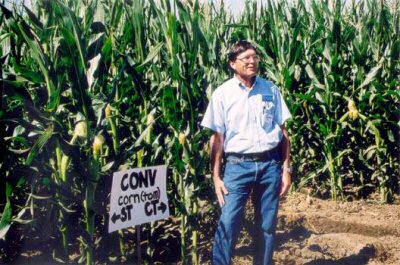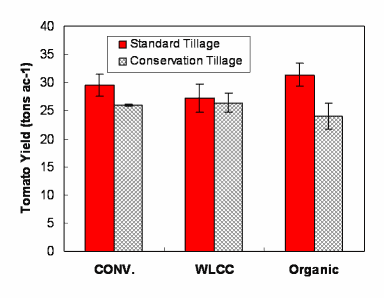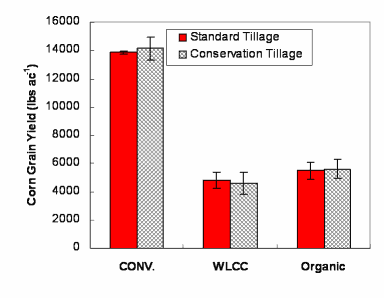|
Spring 2005 - Vol. 5/No. 2
SAFS tillage system comparisons – 2004 yield results
Progress Report: First full season
By Kent Brittan, Gene Miyao, Z. Kabir, Dennis Bryant
and Will
Horwath
| |
 |
| Yolo County farm advisor Kent Brittan describes SAFS conventional farming systems field corn comparison between standard and conservation tillage. |
| |
Results from the 2004 UC Davis Sustainable Agriculture Farming Systems (SAFS) project corn and
tomato conservation tillage (CT) systems are in. We are evaluating them in comparison to standard
tillage (ST) in:
- Conventional winter fallow (CWF),
- Low-input winter legume cover crop (WLCC), and
- Organic (ORG) production systems.
Previous SAFS articles have described some of the challenges faced as we have adapted equipment
to incorporate the cover crops and plant the tomato CT system in a timely fashion
(“Cover/cash crops in tillage systems,”).
Our second season at the SAFS site started out very differently with good soil planting
conditions and a very good growing season compared to 2003, which had a wet spring. Stand
establishment, as affected by tillage, appears to be an ongoing issue in the tomato system,
but not in the corn system.
Tomatoes
Our 2004 SAFS tomato yields averaged 27 tons per acre of marketable fruit, below the 35
tons anticipated countywide yield for 2004. Yields were not significantly different among
conventional, WLCC, or organic production methods (Figure 1). The conservation tillage yield
was significantly lower than that in standard tillage, 25 vs. 29 tons per acre, respectively.
| |
 |
| Figure 1. Tomato marketable yield, SAFS, Russell Ranch, 2004. |
| |
What modifications can be made to improve CT in processing tomatoes? For the organic system,
better weed control tools are needed when in-season cultivation is reduced. In the SAFS
companion research area, a buried drip irrigation system reduced weed competition by maintaining
a dry surface layer, which prevented weed emergence.
We also learned that seedbed condition remains an important factor. Cloddy bed tops impaired
optimal performance of our modified tomato transplanter, resulting in planter wheel slippage
and jamming of the drive mechanism. The poor seedbed led to a 7 percent under-planting of the
target population. With the cloddy condition, we had poorer soil-sealing, resulting in increased
moisture loss from the plug and the soil surrounding the plug. The cloddiness led to an
additional ~6 percent loss of stand in the CT, compared to the ST conventional with only a 1
percent mortality rate.
Lesson learned: Better seedbed preparation was necessary to reduce clod size following
tillage of the legume cover crop. This cloddy condition was particularly pronounced, because
rainfall was marginal in spring 2004, and soil moisture was not replenished prior to planting.
¹
For processing tomatoes, within-season cultivation to maintain bed shape as well as reduce
weed competition, is critical for economic production. Until economical methods are identified
to reduce weed competition and hand-weeding expenses, our research teams need to reassess our
crop management approach. By evaluating the long-term benefits of maintaining semi-permanent
beds, which would eliminate primary fall tillage operations such as subsoiling and disking,
our SAFS research can still provide valuable information to growers while meeting substantial
environmental quality goals.
Corn
Corn yields this season for the conventional farming system averaged over the two tillage
treatments were 13,990 lbs. per acre at 15% moisture compared with a regional average of
10,000 lbs. per acre. Yields were not significantly different between CT and ST for this
system (Table 2). Equipment and methodology for conservation tillage corn production has
been proven elsewhere for decades and, as these data show, works well here.
| |
 |
| Figure 2. Corn grain yield at 15% moisture, SAFS, Russell Ranch, 2004. |
| |
Yields in the winter legume cover crop and organic systems were substantially lower than
those in the conventional system. Planting date, which was delayed to allow the legume cover
crop to achieve full growth potential, may be a major factor in the lower yields. High
surface soil moisture from the cover crop further delayed the incorporation prior to
planting. The conventional systems were planted on March 22, while the WLCC and organic
systems were delayed until May 2. A full-season cultivar was used for all systems. The
five-week delay put this cultivar beyond its optimal yield potential. Additionally, the
seeding rate for the WLCC was reduced from 32,500 to 24,500 plants/acre to compensate for
the anticipated lower nutrient availability².
This may explain the slightly lower yield
for the WLCC compared to the organic. As lab results from plant tissue nutrient levels
become available, further explanation into ‘what happened?’ will help guide our project.
Analysis of plant disease ratings may also add to our understanding. We are anxious to
gather information from all the involved researchers so our group can identify ways to
improve the corn yield in the WLCC and organic systems. Similar corn yield results from
the 2003 season cause us to suspect the problem is complex.
What about our organic farming system? Even with organic premiums and reduced inputs
(seed, tillage and compost) our yields are far too low to make the corn system
economically viable. We clearly need to continue to adjust and improve these farming
systems.
In summary, challenges remain in the implementation of conservation tillage in row
crop systems for the Sacramento Valley. These challenges have kept many growers from
adopting conservation tillage methods and cover cropping to enhance soil quality and
farm income.
These practices, however, have been shown to reduce winter rainfall runoff, an
immediate concern that is confronting growers as they face loss of the federal Clean
Water Act's “ag waiver” (“With loss of ag waiver looming, SAFS researchers shed light
on runoff dilemmas,” http://safs.ucdavis.edu/newsletter/v05n1/v5n1-b.htm). For these
reasons, the adoption of CT and winter cover crops may become viable mitigating
practices to reduce winter runoff. SAFS researchers will continue to examine ways to
effectively implement these practices so that growers have more options to address
upcoming environmental and economic issues.
| ¹ |
Other studies of CT and tomato at the University of California West Side Research
and Extension Center at Five Points have shown more promising results with CT systems
yielding higher than ST. Soil type may have a major influence at the SAFS site where
the soil has more clay content, resulting in the clod problems described above. These
results show that the successful implementation of CT is site-and crop-dependent. See
Transitioning cotton and tomato production systems to conservation tillage, J.P.
Mitchell, K.K. Klonsky, J.B. Baker, R. DeMoura, W.R. Horwath, R.J. Southard, D.S. Munk,
J.F. Wroble, K.J. Hembree, J.J. Veenstra and W.W. Wallender. Submitted to California
Agriculture January 2005.
|
| ² |
Footnote: These results for the corn are contrary to old SAFS results when the
project was located on the Agronomy and Range Science facilities at UC Davis. In fact,
corn yields were often highest in the cover crop system. However, the WLCC
at the old site included supplemental inorganic fertilizer inputs in contrast to the
present site with no added nitrogen.
|
• Table of Contents •
|
|